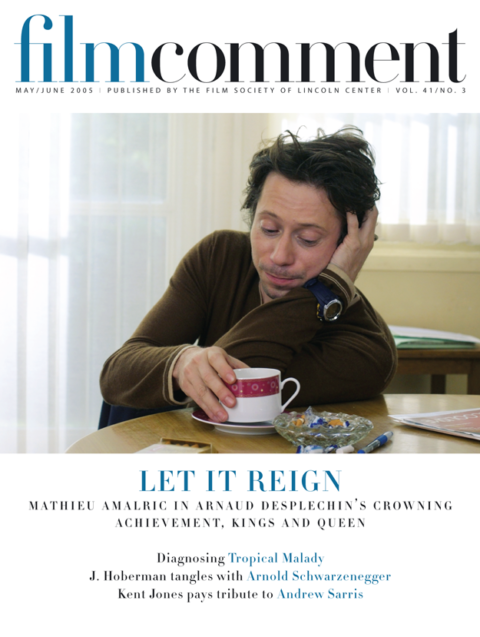
“If you leave me, I'll kill you,” two teenage beauties whisper to each other as they kiss in front of a blazing fire, their silhouetted profiles intersecting like strange flowers. In Pawel Pawlikowski's impressionistic, radiant, and psychologically feverish romance My Summer of Love, which is very loosely based on the central relationship in Helen Cross's 2001 eponymous, Yorkshire-set novel, characters seek salvation by controlling others or surrendering control of their lives, but their words often fuel self-delusion and clear a path for betrayal. A writer-director who has made numerous documentaries in addition to the narrative features The Stringer (98) and Last Resort (00), Pawlikowski works intuitively, with an emphasis on visual storytelling. In My Summer of Love he sketches an emotional landscape as replete with dramatic shifts as the physical terrain, with its hills and valleys, moors and forests.
The movie's heart belongs to its most sarcastic but ardent character: a scrappy, gravelly voiced gamine with a strawberry-blonde mane and abundance of winsome freckles named Mona (Natalie Press), who lives with her ex-con big brother Phil (Paddy Considine) above the Swan, a pub their mother ran before she died of cancer. Having found God while in prison, Phil has poured the pub's inventory down the sink and begun hosting prayer sessions for a flock of childishly pious townsfolk. He also sets about building an enormous crucifix to be planted atop a hill overlooking the town. Dumped by a local married lout and constantly berated by her brother, Mona escapes from her troubles on a scooter. While sunning herself in a meadow one day, she encounters the coolly elegant, dark-haired Tamsin (Emily Blunt), who materializes on a white horse like the heroine of a 19th-century novel.

Mutual curiosity quickly develops into an intoxicating infatuation after Mona accepts an invitation to visit this exotic creature at her house, which is cocooned in ivy, filled with lovely, gleaming objects, and has an aura of enchantment. In her parents' absence, Tamsin swans around her home, telling fantastic stories and hilariously pontificating, advising her friend to read Nietzsche, “Or Freud, you know.” The girls' growing mutual obsession leads to conflicts with Phil, experimentation with the occult, and eventually their own falling-out. An instinctive, mercurial actress, Press plays Mona with alternating wide-eyed sweetness, earthy sensuality, or raucous rebelliousness, while Blunt brings an air of sly complacency to the role of the more manipulative Tamsin; together, they have a believably addictive chemistry. Pawlikowski's treatment of the love scenes is also refreshingly natural, free of any tinge of discomfort with female adolescent sexuality—in many ways theirs could be an adult relationship, or a heterosexual one. At the same time, the movie's down-the-rabbit-hole sense of mystery and mounting exhilaration is heightened by the moody whistling and vocals of Goldfrapp's soundtrack.
Ryszard Lenczewski's superb cinematography effectively captures the rhythm of the girls' volatile interactions and growing obsession. His handheld camerawork has a quicksilver alertness, at one point imperceptibly zooming in and out of Mona's face during the scene in which she finds Tamsin playing Saint-Saëns's “The Swan” on the cello after entering her friend's magical house for the first time. Pawlikowski has a sculptural sense of space, which is often heightened by imaginative framing and vivid color: some of the film's most resonant images suggest different levels of reality between the interior and exterior of the house, or between the working-class homes in the valley and Tamsin's posh manse nestled in a wooded area high above. In one ravishing panoramic shot, the cross, which Phil has successfully mounted on a golden hill, parallels a tall smokestack rising from the town in the foreground, evoking the born-again Christians' yearning to escape their mundane lives in an otherworldly place marred by postindustrial decay. Pawlikowski, who created Phil's character by drawing on his experiences working on a documentary about a group of British fundamentalist Christians, pointedly contrasts the vitality of Mona and Tamsin's love affair with Phil's brittle, puritanical fervor. He has also stated in several interviews his awareness that the location was once the site of witch trials and religious wars and that he aimed for a feeling of timelessness by eliminating signs of contemporary mass culture. My Summer of Love's depiction of elemental passion set against deadening piety echoes similar themes in such Yorkshire-set Brontë works as Wuthering Heights and Jane Eyre, while the lush landscapes, industrial blight, thwarted passion, and memories of pagan ritual recall novels by Thomas Hardy (think Tess of the d'Urbervilles arrested at Stonehenge after murdering for love). If this bold and lyrical movie has a flaw, it's that it may leave some viewers wishing its compelling characters inhabited a less impressionistic and more fleshed-out, novelistic narrative. But, although he aggressively reimagines the summer love story as a tale of grand passion evocative of romantic and post-romantic literature, Pawlikowski stays true to its fleeting essence.








